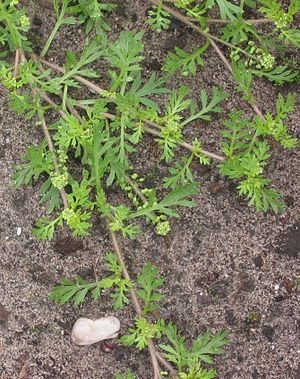Two-nodular crow's foot
| Two-nodular crow's foot | ||||||||||||
|---|---|---|---|---|---|---|---|---|---|---|---|---|

Two-nodular crow's foot ( Lepidium didymum ) |
||||||||||||
| Systematics | ||||||||||||
|
||||||||||||
| Scientific name | ||||||||||||
| Lepidium didymum | ||||||||||||
| L. |
The two-nodal crow's foot ( Lepidium didymum ) is a species of the cress ( Lepidium ) in the cruciferous family (Brassicaceae). South America is assumed to be the original range of the species, which now occurs worldwide.
features
The herbaceous plant , which is usually annual , rarely also biennial, reaches a length of 10 to 45 (rarely up to 70) cm. It gives off a foul smelling odor. The plant is hairless or has straight plant hairs about 1 mm long. The stems grow prostrate to ascending and are usually branched at the base.
The alternate leaves are petiolate and pinnate. The basal leaves are pinnate almost to the midrib and 4 to 10 cm long. On both sides of the spindle, 2 to 7 mm long, serrated or incised, pointed flaps on the sides. The middle leaves are similar to those at the base and measure 1.5 to 4.5 × 0.5 to 1.2 cm. The leaves gradually get smaller towards the top and are less divided. The lobes are elongated lanceolate to elliptical.
Opposite the stem leaves are the racemose inflorescences . The pedicels are longer than the flowers. The white to yellowish egg-shaped petals are 0.4 to 0.5 mm in size. They are shorter than the sepals and can be completely absent. The two (or rarely four) stamens have white stamens and purple anthers . The flowering period is mainly March to June.
The 2 mm long stalked pods consist of two almost spherical halves, are edged, reticulate, wrinkled and without jagged edges. The width of the pods is 2 to 3 mm. The fruit bodies are hairless, slender ascending or slightly bent back with a size of 1.5 to 2.5 mm.
The plant has the number of chromosomes 2n = 32.
Occurrence
The two-nodular crow's foot is originally found in South America, but is a neophyte in Europe, Africa, Asia, Australia, New Zealand, North America, Mexico and on islands in the Pacific. The two-nodular crow's foot prefers to grow in nitrogen-rich, bright and warm places. It is widespread worldwide and mainly settles near the coast at altitudes of up to 1000 m. The preferred sites are roadsides and waste areas and fields with companies of the Association Polygono-Chenopodion or impact plant communities of the Association Polygonion avicularis .
Synonyms
Synonyms for Lepidium didymum L. are: Carara didyma (L.) Britton , Coronopus didymus (L.) Sm. , Coronopus pinnatifida DC. , Senebiera pinnatifida DC. , Senebiera didyma (L.) Pers. , Senebiera incisa Willdenow .,
Sources and further information
The article is mainly based on the following documents:
- Oskar Sebald : Guide through nature. Wild plants of Central Europe. ADAC Verlag, Munich 1989, ISBN 3-87003-352-5 .
- Entry in the Flora of North America .
Individual evidence
- ↑ a b c Lepidium in the Germplasm Resources Information Network (GRIN), USDA , ARS , National Genetic Resources Program. National Germplasm Resources Laboratory, Beltsville, Maryland. Retrieved July 28, 2017.
- ↑ a b Erich Oberdorfer : Plant-sociological excursion flora for Germany and neighboring areas . With the collaboration of Angelika Schwabe and Theo Müller. 8th, heavily revised and expanded edition. Eugen Ulmer, Stuttgart (Hohenheim) 2001, ISBN 3-8001-3131-5 , pp. 446 .
- ↑ Flora of North America , accessed June 28, 2010.
Web links
- Two-nodular crow's foot. In: FloraWeb.de.
- Distribution map for Germany. In: Floraweb .
- Coronopus didymus (L.) Sm. In: Info Flora , the national data and information center for Swiss flora . Retrieved October 26, 2015.
- Profile of the University of Vienna.
- Distribution in the northern hemisphere according to: Eric Hultén , Magnus Fries: Atlas of North European vascular plants 1986, ISBN 3-87429-263-0
- Thomas Meyer: Data sheet with identification key and photos at Flora-de: Flora von Deutschland (old name of the website: Flowers in Swabia )
